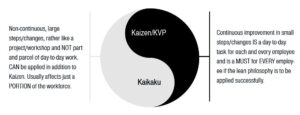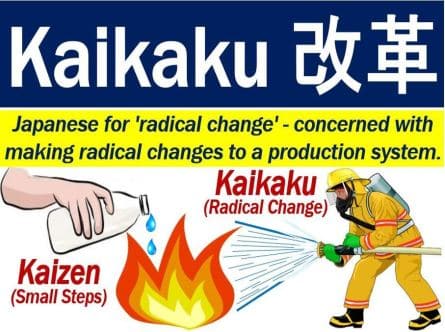Sometimes, you need a radical, revolutionary improvement and change–that’s when you need Kaikaku. In contrast to Kaizen, Kaikaku is a revolutionary method and is for those moments when part of implementing Lean requires the need for a more radical step change. When a problem arises that requires an immediate effective change, usually for a larger project, Kaikaku comes into play.
Kaikaku: Kaizen’s secret twin
 When organizations work to adopt Lean processing and methodologies, one of the first approaches they learn about is Kaizen. Translated from Japanese, “Kai” means change, and “Zen” means for the better. Kaizen is an evolutionary method of adopting continuous improvements every day—day-after-day.
When organizations work to adopt Lean processing and methodologies, one of the first approaches they learn about is Kaizen. Translated from Japanese, “Kai” means change, and “Zen” means for the better. Kaizen is an evolutionary method of adopting continuous improvements every day—day-after-day.
Kaizen is the familiar kind of improvements used when it comes to Lean; it involves taking your time and effort to work through current processes. Kaizen requires an organization to implement incremental changes to achieve continuous improvement.
In fact, because it’s so popular, it’s easy to assume that Kaizen is the only methodology to Lean.
However, Kaizen has a much less-known, quiet, equally powerful twin named Kaikaku. In Lean, Kaizen and Kaikaku operate like Yin and Yang.
What is Kaikaku?
Like Kaizen, Kaikaku begins with “Kai”—or change, but Kaikaku means a radical change during a limited time. Instead of daily continuous improvement, Kaikaku is a one-time focused push for change.
The main identifiable differences between Kaizen and Kaikaku are the size of the action taken to achieve Lean, and the length of time it takes for that action to have a noticeable effect.
Kaikaku is often used as a precursor to implementing Kaizen in many organizations. Kaikaku breaks the standards and status quo in an organization.
Kaikaku in action
 For example, imagine the installation of new operating software in your organization. Kaikaku is the installation of the software—breaking away from using the old software completely. Kaizen is the staff training for the software and the continuous use of the software. Kaikaku is intended to bring about radical change, and Kaizen is to sustain that change and make further improvements.
For example, imagine the installation of new operating software in your organization. Kaikaku is the installation of the software—breaking away from using the old software completely. Kaizen is the staff training for the software and the continuous use of the software. Kaikaku is intended to bring about radical change, and Kaizen is to sustain that change and make further improvements.
Both improvements require a group of individuals who are vested and believe in the organization that they are trying to improve in order to be successful.
Both Kaizen and Kaikaku are essential strategies. Without a culture of Kaizen, a Kaikaku cannot succeed. Successful long-term transformations require a series of short-term successes, the engagement of everyone in the organization, and a bias towards practical improvement.
Kaizen and Kaikaku aren’t mutually exclusive. They both have their place in an organization’s arsenal of Lean tools. Kaikaku is a tool that is used in addition to Kaizen, not instead of Kaizen. In many cases Kaikaku is used initially, and then Kaizen provides the long-term transformation.
The Kaizen Event
A hybrid of Kaikaku and Kaizen is the Kaizen Event or Kaizen Blitz. Which targets a radical improvement in a limited area, such as just one area of production, typically during an intense week.
The 10 commandments of Kaikaku
Using Kaikaku is like setting off an explosion in the workplace. It’s revolutionary. It breaks existing paradigms and throws out old ways of thinking. It’s focused on achieving radical improvement over a short time period.
A good place to start understanding Kaikaku is with Hiroyuki Hirano’s Ten Commandments of Kaikaku:
- Throw out the traditional concept of manufacturing methods.
- Think of how the new method will work; not how it won’t work.
- Don’t accept excuses and don’t accept limits.
- Totally deny the status quo, be ready to start new.
- Don’t seek perfection. A 50% implementation rate is fine as long as it is done on the spot.
- Correct mistakes the moment they are found.
- Don’t spend money on Kaikaku.
- Problems give you a chance to use your brains.
- Ask “why” five times.
- Ideas from ten people are better than one person’s knowledge.
The seventh commandment of Kaikaku is important: “Don’t spend money on Kaikaku.” Kaikaku isn’t about buying lots of new, high-tech machines and equipment. Kaikaku is about a new way of thinking and a new way of doing things. For example, by redesigning a product, a step in the manufacturing process might be eliminated.
The point is that good ideas deliver more value than spending lots of money. That’s why more than half of the Ten Commandments of Kaikaku are people oriented. They are about freeing people to use their experience, knowledge, and creativity to come up with new ideas and better ways to get things done.
Kaikaku: Swinging for the fences
One thing to remember is the risk/reward factor is significantly higher with Kaikaku over Kaizen. If you’re a sports fan, think of baseball and the difference between a home run hitter and one that hits for a high average with lots of base hits. The home run hitter goes up swinging for the fences every time.
The reward is high because if they connect, the result is a minimum of one run for the team. The risk is that if they strike out your team now has an out for the inning. However, the batter who hits for average is up there just trying to make contact and get on base. The reward is low because they may just get a single and never get further than first base, but the chances of them getting out is also low.
The baseball analogy might not work for everyone, but the point is: you can use them both to win! Baseball, like all team sports, takes a team to win. Therefore, intertwining your singles and home run hitters can lead to tremendous success is done correctly. The same could be said about Kaizen and Kaikaku.
The Importance of Teamwork in Kaikaku
In order for your organization to have success with Kaikaku, you have to appreciate the importance and value Kaizen has. If not, your organization’s ability to sustain the “radical” change, may fall flat on its face. When dealt with a problem or situation that requires a revolutionary change (Kaikaku) to happen, you may not always get the initial results you were looking for. However, through continuous improvement (Kaizen), you can continue to push towards the results you were initially looking for.



